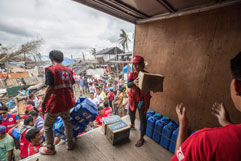
Outside a crowded hall in Dagami, Leyte, scores of people are in line to register with the volunteers of the Philippine Red Cross cash distribution program. A group of mothers, who have each just collected 5,000 pesos, chat and share their experiences of the last 100 days since Typhoon Haiyan hit the islands.
The typhoon, one of the most powerful in recorded history, made landfall in the Visayas region of central Philippines. Sixteen million people were affected, 1 million homes were damaged or destroyed and over 5 million people saw their livelihoods ruined.
The women from Dagami recall the difficulties they have faced; what it was like to have the roofs ripped from their homes, to go without food and water, to live under a tarpaulin and be soaked to the skin when it rains.
On the positive side, they have been recipients of a massive relief effort but despite this, Evelyn, Golie, Jocelyn and Jenny are really worried about the future. Their main concern is being ready for when the next typhoon comes along. Like most survivors, they want a secure income, durable shelter and access to education for their children.
Over the last 100 days, the Philippine Red Cross reached over 1 million people with emergency relief – cooked meals, dry food rations, non-food household items – and covered nearly a quarter of total shelter needs in the affected area. The Red Cross has also distributed emergency cash grants to almost 50,000 households.
As part of the recovery plan, the challenge now for the Red Cross and other humanitarian agencies will be to focus on the recovery needs of survivors particularly in the areas of rebuilding homes and restoring livelihoods.
A recent Philippine Red Cross-led recovery assessment vindicated this approach with a strong recommendation to integrate shelter and livelihood programs and for better geographic targeting of the poorest areas. Among the recommendations to promote livelihoods were activities to restore the purchasing power of farmers and fishermen, programs to diversify income sources and skills training.
The Canadian Red Cross thanks individual, corporate and government donors for their support. To find out how your donation continues to make a difference, read the three-month donor report.